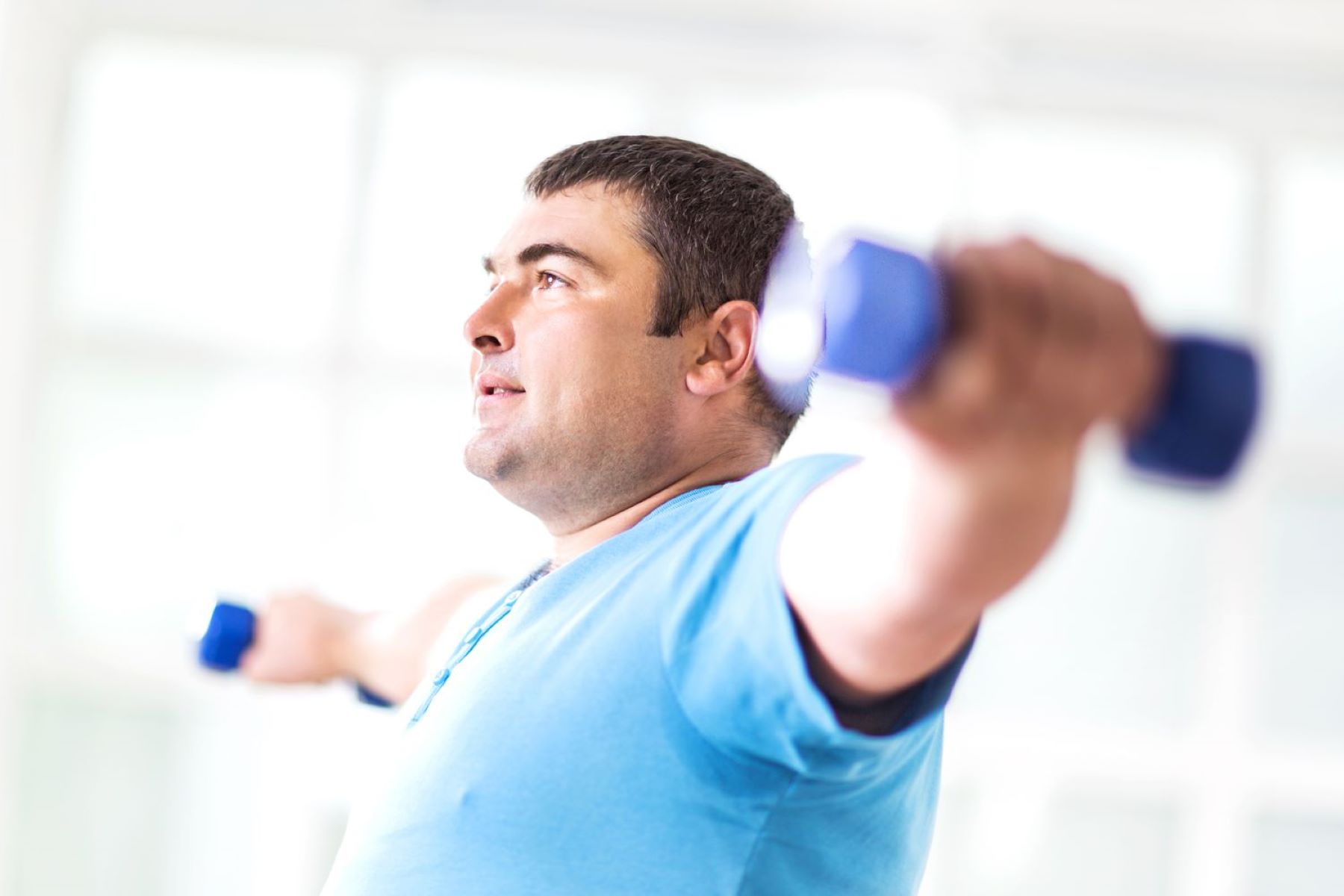Home>Misc>Featured>How Do You Measure Cardiovascular Fitness


Featured
How Do You Measure Cardiovascular Fitness
Modified: August 21, 2023
Discover the best methods to measure cardiovascular fitness in this featured article. Find out how you can track your progress and improve your heart health through effective testing.
Introduction
Cardiovascular fitness is a key marker of overall health and plays a vital role in maintaining optimal physical functioning. It refers to the ability of the cardiovascular system to deliver oxygen and nutrients to the muscles during exercise, as well as remove waste products efficiently. As a result, measuring cardiovascular fitness is crucial for assessing an individual’s aerobic capacity and determining their level of fitness.
Regularly measuring cardiovascular fitness can provide valuable insights into an individual’s health status, help identify potential risk factors for cardiovascular diseases, and monitor the effectiveness of exercise interventions. It also allows individuals to set realistic goals for improving their fitness levels and track their progress over time.
There are various methods available to measure cardiovascular fitness, each with its own advantages and limitations. Maximal oxygen consumption (VO2max) is considered the gold standard for assessing aerobic capacity, providing a comprehensive measure of a person’s ability to utilize oxygen during intense exercise. Heart rate variability (HRV) is another effective method that measures the variability in the time intervals between heartbeats, offering insights into autonomic nervous system function.
Submaximal exercise tests, such as the step test or the 6-minute walk test, are popular alternatives that estimate cardiovascular fitness levels. These tests are less intense and more suitable for individuals with limited exercise capabilities or medical conditions. Physical fitness tests, which assess an individual’s overall fitness through various exercises like running, cycling, or swimming, can also provide a comprehensive picture of cardiovascular fitness.
However, it is important to consider various factors that can influence cardiovascular fitness measurements. Age and gender play a significant role, with cardiovascular fitness generally decreasing with age and differences existing between males and females. Body composition, specifically the ratio of muscle mass to fat mass, can also impact cardiovascular fitness measurements. Additionally, overall health and the presence of medical conditions can affect an individual’s cardiovascular fitness levels.
Improving cardiovascular fitness can have numerous benefits for overall health and well-being. It enhances the efficiency of the cardiovascular system, reducing the risk of heart diseases and improving circulation. Regular exercise and physical activity can also contribute to weight management, enhanced mood, increased energy levels, and improved cognitive function. Therefore, measuring cardiovascular fitness and striving to improve it should be a priority for everyone.
Importance of Measuring Cardiovascular Fitness
Measuring cardiovascular fitness is of utmost importance in assessing an individual’s overall health and well-being. It provides valuable information about the efficiency of the cardiovascular system, the body’s ability to deliver oxygen and nutrients to the muscles during exercise, and the overall level of fitness. Here are some key reasons why measuring cardiovascular fitness is crucial:
- Evaluating Aerobic Capacity: Cardiovascular fitness is a direct reflection of an individual’s aerobic capacity. By measuring cardiovascular fitness, we can assess how efficiently the body uses oxygen during exercise. This information is valuable in determining the overall endurance and fitness level of an individual.
- Identifying Health Risks: Measuring cardiovascular fitness can help identify potential risk factors for cardiovascular diseases. Poor cardiovascular fitness is often associated with an increased risk of developing conditions such as heart disease, high blood pressure, and metabolic disorders. Regular assessments can serve as a preventative measure and help individuals take proactive steps to improve their fitness.
- Monitoring Fitness Progress: Measuring cardiovascular fitness allows individuals to track their progress over time. By establishing a baseline measurement and periodically reassessing, individuals can see tangible improvements in their fitness levels. This serves as a motivating factor and helps maintain consistency in exercise routines.
- Setting Realistic Fitness Goals: Accurate measurements of cardiovascular fitness provide individuals with insights into their current fitness levels. This information enables them to set realistic and attainable fitness goals, whether it be improving endurance, increasing exercise intensity, or achieving specific performance targets.
- Efficiency in Exercise Prescription: Measuring cardiovascular fitness helps fitness professionals design personalized exercise programs tailored to the individual’s needs. By understanding an individual’s current fitness level, trainers and clinicians can prescribe exercises at appropriate intensities and durations to optimize health benefits and avoid overexertion or injuries.
Measuring cardiovascular fitness is essential for understanding the body’s cardiovascular health status, assessing an individual’s fitness level, and identifying potential risks and areas for improvement. It empowers individuals to take control of their health by implementing targeted exercise programs and lifestyle changes to enhance their cardiovascular fitness. Regular assessments and monitoring are key to maintaining and improving cardiovascular fitness over time.
Methods for Measuring Cardiovascular Fitness
There are various methods available for measuring cardiovascular fitness, each utilizing different techniques and providing unique insights into an individual’s aerobic capacity and overall fitness level. Here are four common methods used:
- Maximal Oxygen Consumption (VO2max): This method is considered the gold standard for assessing cardiovascular fitness. VO2max measures the maximum amount of oxygen a person can utilize during intense exercise. It is typically measured using specialized equipment that analyzes the volume and gas concentrations of inhaled and exhaled air during a graded exercise test. The results provide valuable information about an individual’s aerobic capacity and overall fitness level.
- Heart Rate Variability (HRV): HRV measures the variability in the time intervals between heartbeats, reflecting the body’s autonomic nervous system function. It is commonly used as a non-invasive method to assess cardiovascular fitness. HRV measurements can provide insights into the body’s ability to adapt to stress, recover efficiently, and indicate overall cardiovascular health.
- Submaximal Exercise Tests: Submaximal exercise tests estimate an individual’s cardiovascular fitness using less intense exercise protocols. Examples of these tests include the step test, the 6-minute walk test, or the Astrand-Rhyming cycle test. These tests are appropriate for individuals with limited exercise capabilities or certain medical conditions. They provide an estimation of cardiovascular fitness levels based on heart rate response and perceived exertion during submaximal exercise.
- Physical Fitness Tests: Physical fitness tests assess an individual’s overall fitness, which includes cardiovascular fitness as one component. These tests often involve activities such as running, cycling, swimming, or a combination of different exercises. Fitness professionals may use tests like the Cooper 12-minute run, the Bruce treadmill test, or the 1.5-mile run to evaluate an individual’s cardiovascular fitness and overall physical performance.
These methods for measuring cardiovascular fitness offer valuable insights into an individual’s aerobic capacity, endurance, and overall health. It is important to note that the choice of method depends on various factors such as the individual’s fitness level, accessibility to equipment, and their specific goals. Consulting with a qualified fitness professional or healthcare provider can help determine the most appropriate method for measuring cardiovascular fitness based on individual circumstances.
Maximal Oxygen Consumption (VO2max)
Maximal oxygen consumption (VO2max) is considered the gold standard for measuring cardiovascular fitness. It quantifies the maximum amount of oxygen an individual can utilize during intense exercise. VO2max reflects an individual’s aerobic capacity, which is closely linked to their endurance and overall fitness level. The higher the VO2max, the more efficiently the cardiovascular system can deliver oxygen to the muscles.
Measuring VO2max involves performing a graded exercise test, typically on a treadmill or stationary bike, while monitoring the individual’s oxygen consumption and heart rate. The exercise test starts at a relatively low intensity and gradually increases in difficulty, progressing to higher levels of intensity until the participant reaches exhaustion. By analyzing the volume and gas concentrations of inhaled and exhaled air during the test, the VO2max value can be determined.
VO2max is expressed as milliliters of oxygen per kilogram of body weight per minute (ml/kg/min). This value provides a direct measure of an individual’s cardiovascular fitness. Elite endurance athletes often have higher VO2max values compared to sedentary individuals or those with lower fitness levels.
Measuring VO2max is typically performed in a specialized lab or fitness facility that has the necessary equipment to analyze the respiratory gases. However, there are also portable devices available that can estimate VO2max based on heart rate data and other factors. These devices provide a convenient option for estimating cardiovascular fitness in various settings.
VO2max is influenced by various factors, including genetics, training status, age, and gender. Regular aerobic exercise can significantly improve VO2max, indicating an improvement in cardiovascular fitness. Higher levels of VO2max are associated with numerous health benefits, such as a reduced risk of cardiovascular disease, increased endurance, improved athletic performance, and enhanced overall well-being.
It is important to note that estimating VO2max with high accuracy requires proper equipment and expertise. Therefore, it is advisable to consult with a trained professional, such as an exercise physiologist or fitness specialist, to perform VO2max testing accurately and safely.
Heart Rate Variability (HRV)
Heart rate variability (HRV) is a method for measuring cardiovascular fitness by assessing the variability in the time intervals between heartbeats. It provides insights into the functioning of the autonomic nervous system, which regulates heart rate and other vital processes in the body. HRV is a non-invasive and widely used method to evaluate the overall cardiovascular health and fitness level of an individual.
HRV is measured by analyzing the beat-to-beat intervals between successive heartbeats. Greater variability between these intervals indicates a more flexible and adaptable autonomic nervous system, which is associated with better cardiovascular health. On the other hand, reduced HRV may suggest increased sympathetic nervous system activity and decreased parasympathetic nervous system activity, which are linked to stress and decreased cardiovascular fitness.
The measurement of HRV involves using a heart rate monitor, typically worn as a chest strap or a wrist-based device, to record the electrocardiogram (ECG) waveform. Specialized software then analyzes the beat-to-beat intervals, calculating various HRV parameters such as the standard deviation of normal-to-normal (SDNN) intervals, the root mean square of successive differences (RMSSD), and the frequency domain measures such as the high-frequency (HF) and low-frequency (LF) components.
HRV can be influenced by multiple factors, including age, stress levels, sleep quality, physical fitness, and overall health. Regular exercise and physical fitness training have been shown to increase HRV, indicating a positive impact on cardiovascular health. Conversely, chronic stress, fatigue, and certain medical conditions can result in reduced HRV.
By measuring HRV, individuals and healthcare professionals can gain valuable information about an individual’s autonomic nervous system function, stress levels, and overall cardiovascular fitness. Monitoring HRV over time can help identify patterns and trends, providing insights into the effectiveness of stress management techniques, exercise interventions, and lifestyle modifications.
It is important to note that HRV measurements should be interpreted by trained professionals in conjunction with other clinical or fitness assessments. Additionally, the availability of various HRV analysis tools and apps makes it possible for individuals to track and monitor their HRV on a daily basis, helping them gain a deeper understanding of their body’s responses to stress, exercise, and other lifestyle factors.
Submaximal Exercise Tests
Submaximal exercise tests are alternative methods for measuring cardiovascular fitness that involve performing exercises at submaximal intensities. These tests are particularly useful for individuals who may have limitations or medical conditions that prevent them from engaging in maximal effort tests. Submaximal exercise tests provide an estimation of cardiovascular fitness levels based on heart rate response and perceived exertion during the exercise.
Examples of submaximal exercise tests include the step test, the 6-minute walk test, and the Astrand-Rhyming cycle test. In a step test, individuals step up and down a platform or a set of stairs for a specific duration, while heart rate is monitored. The 6-minute walk test measures the distance an individual can walk in 6 minutes while tracking heart rate. The Astrand-Rhyming cycle test involves cycling at a specific workload for a set period, with heart rate measurements taken during the test.
During submaximal exercise tests, heart rate response is monitored and recorded to estimate the individual’s cardiovascular fitness level. The heart rate response is then compared to established norms or predictive equations to determine the approximate level of cardiovascular fitness.
Submaximal exercise tests have several advantages. First, they are less strenuous than maximal effort tests and are therefore safer for individuals with certain medical conditions or limited exercise capabilities. These tests provide a practical alternative to accurately estimate cardiovascular fitness levels in a controlled and safe environment.
However, it is important to note that submaximal exercise tests have limitations. They provide estimations rather than direct measurements of cardiovascular fitness. Factors such as individual variability and differences in exercise technique or effort can affect the accuracy of the results. Additionally, submaximal exercise tests may not be as precise as maximal effort tests like VO2max testing, which directly measure aerobic capacity.
Despite these limitations, submaximal exercise tests can still provide useful information about an individual’s cardiovascular fitness. They can be easily administered in various settings, such as fitness facilities or healthcare clinics, and are suitable for individuals who may not be able to undergo strenuous exercise tests. Submaximal exercise tests offer a practical and accessible option for assessing cardiovascular fitness levels and tracking improvements over time.
Physical Fitness Tests
Physical fitness tests are comprehensive assessments that evaluate an individual’s overall fitness, including cardiovascular fitness. These tests involve performing a series of exercises that target different aspects of physical fitness such as cardiovascular endurance, muscular strength, flexibility, and body composition. By assessing multiple fitness components, physical fitness tests can provide a comprehensive picture of an individual’s overall fitness level.
Various physical fitness tests are available, each focusing on different aspects of fitness. Common examples include the Cooper 12-minute run, the Bruce treadmill test, the 1.5-mile run, and the multi-stage fitness test (also known as the beep test or shuttle run test).
The Cooper 12-minute run requires participants to run as far as they can in 12 minutes, measuring the distance covered to determine cardiovascular endurance. The Bruce treadmill test is a graded exercise test that involves running on a treadmill at increasing levels of speed and inclination until exhaustion. The distance covered and heart rate response during the test provide insights into cardiovascular fitness levels.
The 1.5-mile run test assesses an individual’s running endurance by measuring the time taken to complete a 1.5-mile distance. The multi-stage fitness test is a shuttle run test where participants run between two markers, dictated by audio cues, with progressively shorter time intervals. The test is repeated until the individual can no longer maintain the required pace, providing an indicator of cardiovascular endurance.
By performing physical fitness tests, individuals and fitness professionals can evaluate an individual’s cardiovascular fitness in the context of their overall physical fitness levels. These tests provide tangible performance measurements, such as distance covered or time taken, making it easier to set goals and track progress over time.
It’s important to remember that physical fitness tests should be conducted in a controlled and supervised environment, especially for individuals with limited exercise experience or existing health conditions. Proper warm-up and cool-down techniques, as well as safety precautions, should be followed during these tests to minimize the risk of injury.
Physical fitness tests offer a holistic approach to measuring cardiovascular fitness, as they take into account other important dimensions of fitness as well. By incorporating various exercises and fitness components, these tests provide valuable information about an individual’s overall physical capacity and can help guide the development of personalized exercise programs to improve cardiovascular fitness and overall health.
Factors Affecting Cardiovascular Fitness Measurements
Several factors can influence the results of cardiovascular fitness measurements. It is important to consider these factors when interpreting test results and determining an individual’s level of cardiovascular fitness. Here are some key factors that can affect cardiovascular fitness measurements:
- Age and Gender: Age and gender play significant roles in cardiovascular fitness. Generally, cardiovascular fitness tends to decline with age due to changes in metabolism, muscle mass, and overall fitness levels. Additionally, there may be physiological differences between males and females that can impact cardiovascular fitness measurements.
- Body Composition: Body composition, specifically the ratio of muscle mass to fat mass, can influence cardiovascular fitness. Individuals with higher muscle mass and lower body fat tend to have better cardiovascular fitness. Muscle tissue requires more oxygen during exercise, prompting the cardiovascular system to work more efficiently to deliver it.
- Overall Health and Medical Conditions: Pre-existing medical conditions can affect cardiovascular fitness measurements. Conditions such as heart disease, respiratory disorders, and metabolic disorders can impact an individual’s ability to perform exercise, leading to reduced cardiovascular fitness levels. Additionally, medications taken for certain medical conditions can affect heart rate and other cardiovascular parameters during exercise.
- Training Status and Exercise Habits: Regular exercise and physical activity can significantly improve cardiovascular fitness. Individuals who engage in consistent exercise and lead an active lifestyle are likely to have better cardiovascular fitness compared to sedentary individuals. Training status and exercise habits can influence cardiovascular fitness measurements, as well as the response to exercise tests.
- Environmental Conditions: Environmental factors such as altitude, temperature, and humidity can affect cardiovascular fitness measurements. Exercise at higher altitudes or in extreme weather conditions may increase the intensity of the exercise and impact the cardiovascular response.
It is important to consider these factors when interpreting and comparing cardiovascular fitness measurements. When conducting measurements or assessing an individual’s fitness level, it is recommended to account for these factors to ensure a more accurate evaluation of cardiovascular fitness levels. Additionally, consulting with a qualified fitness professional or healthcare provider can provide further guidance on interpreting results in the context of individual circumstances and characteristics.
Age and Gender
Age and gender are two key factors that can significantly influence cardiovascular fitness measurements. Understanding how age and gender impact cardiovascular fitness is crucial for accurately interpreting fitness test results and establishing appropriate benchmarks for individuals. Here’s a closer look at the role of age and gender in cardiovascular fitness:
Age: Cardiovascular fitness tends to decline with age due to a variety of factors. As individuals get older, several physiological changes occur that contribute to reduced cardiovascular fitness. These changes include a decline in maximum heart rate, a decrease in muscle mass, and a decrease in the body’s ability to utilize oxygen efficiently. Age-related health conditions, such as cardiovascular disease and other chronic illnesses, can also impact cardiovascular fitness. It’s worth noting that while cardiovascular fitness naturally decreases with age, regular exercise and an active lifestyle can help mitigate this decline and maintain a higher level of fitness.
Gender: Gender can also affect cardiovascular fitness measurements. On average, males tend to have higher levels of cardiovascular fitness compared to females. This difference can be attributed to physiological factors such as larger heart size, greater muscle mass, and higher hemoglobin levels in males. These factors contribute to a higher oxygen-carrying capacity and better overall cardiovascular performance. However, it’s important to recognize that individual variations exist within genders, and many fit and highly trained females can achieve cardiovascular fitness levels similar to or surpassing those of less fit males.
When assessing cardiovascular fitness, age- and gender-specific norms and benchmarks are often used to compare individuals. These norms consider the typical range of cardiovascular fitness levels observed in specific age groups and genders. By utilizing age- and gender-specific norms, professionals can gauge an individual’s fitness level relative to their peers and provide more accurate recommendations for improvement.
It’s important to note that regardless of age or gender, regular exercise and training can have a positive impact on cardiovascular fitness. Engaging in aerobic activities such as running, cycling, swimming, or brisk walking can improve aerobic capacity, strengthen the cardiovascular system, and enhance overall fitness levels. Therefore, individuals of all ages and genders are encouraged to participate in regular physical activity to maintain or improve their cardiovascular fitness.
Body Composition
Body composition, specifically the ratio of muscle mass to fat mass, is an important factor that can significantly impact cardiovascular fitness measurements. Understanding the relationship between body composition and cardiovascular fitness is crucial for accurately assessing an individual’s fitness level and understanding the potential impact of body composition on cardiovascular health. Here’s a closer look at how body composition influences cardiovascular fitness:
Muscle Mass: Having a higher ratio of muscle mass to fat mass can positively influence cardiovascular fitness. Muscles require oxygen during exercise, and individuals with greater muscle mass have a larger number of active muscle fibers. This, in turn, requires the cardiovascular system to work more efficiently to deliver oxygenated blood to the working muscles. Therefore, individuals with a higher percentage of muscle mass often have better cardiovascular fitness levels.
Fat Mass: Excessive fat mass has a negative impact on cardiovascular fitness. Higher levels of body fat can lead to increased strain on the cardiovascular system and reduced efficiency. Excess fat tissue is associated with increased inflammation and higher levels of circulating lipids, which can impair blood flow and compromise cardiovascular function. Therefore, individuals with higher levels of body fat may have lower cardiovascular fitness levels.
It’s worth noting that body composition can vary significantly among individuals, even if they have similar body weight or body mass index (BMI). BMI, which is a simple calculation based on height and weight, may not accurately reflect an individual’s body composition or provide insights into their cardiovascular fitness. Therefore, measuring body composition through methods such as bioelectrical impedance analysis (BIA), dual-energy X-ray absorptiometry (DXA), or skinfold measurements can provide a more accurate assessment of an individual’s fat mass and muscle mass.
Improving body composition through a combination of regular exercise and a balanced diet can positively impact cardiovascular fitness. Engaging in strength training exercises can help increase muscle mass, while aerobic exercises can aid in decreasing body fat percentage. Achieving a healthy balance between muscle and fat mass not only improves cardiovascular fitness but also contributes to overall health and well-being.
It’s important to remember that cardiovascular fitness should not be solely based on body composition. While individuals with higher muscle mass and lower body fat tend to have better cardiovascular fitness levels, other factors such as aerobic capacity, endurance, and overall health should also be considered. A comprehensive assessment of cardiovascular fitness should take into account multiple measurements and factors to provide a more accurate evaluation.
Overall Health and Medical Conditions
The overall health of an individual and the presence of medical conditions can have a significant impact on cardiovascular fitness measurements. Considering the influence of overall health and medical conditions is crucial when interpreting cardiovascular fitness results and understanding the implications for cardiovascular health. Here’s an exploration of how these factors affect cardiovascular fitness:
Medical Conditions: Certain medical conditions can directly impact cardiovascular fitness levels. Cardiovascular diseases, such as coronary artery disease, heart failure, and arrhythmias, can impair the heart’s ability to function effectively. Respiratory disorders, such as asthma or chronic obstructive pulmonary disease (COPD), can affect the lungs’ ability to deliver oxygen to the body. Metabolic disorders, like diabetes or obesity, can influence cardiovascular fitness by altering metabolic pathways and affecting blood glucose regulation. Individuals with such conditions often have lower cardiovascular fitness levels, as their bodies may face limitations in oxygen utilization and overall cardiovascular function.
Medications: Medications taken for certain medical conditions can affect cardiovascular fitness measurements as well. Some medications, particularly beta-blockers or other heart rate-lowering medications, can lower heart rate and potentially impact exercise performance. It’s important to consider these medications when assessing cardiovascular fitness levels, as they may influence the heart rate response during exercise tests.
Overall Health: An individual’s overall health status can impact cardiovascular fitness. Chronic stress, fatigue, and poor sleep habits can affect cardiovascular fitness levels by increasing cortisol levels and disrupting physiological processes. Additionally, lifestyle factors such as smoking, excessive alcohol consumption, or poor nutrition can all have detrimental effects on cardiovascular health and overall fitness.
When measuring cardiovascular fitness, it is crucial to take into account an individual’s overall health and any existing medical conditions. These factors may influence an individual’s exercise capabilities, heart rate response, and overall cardiovascular fitness measurement results. Working with a healthcare professional or a qualified fitness specialist can help ensure that cardiovascular fitness assessments are appropriately adjusted and interpreted in the context of an individual’s specific health conditions and overall health status.
Improving cardiovascular fitness for individuals with medical conditions should be approached with caution and guidance from healthcare professionals. Tailored exercise programs, taking into account the specific medical condition and individual limitations, can help gradually improve cardiovascular fitness while ensuring safety and minimizing potential risks.
Benefits of Improving Cardiovascular Fitness
Improving cardiovascular fitness offers a wide range of benefits for overall health and well-being. As one of the key markers of physical fitness, cardiovascular fitness plays a crucial role in maintaining optimal health and functioning. Here are some key benefits of improving cardiovascular fitness:
- Reduced Risk of Cardiovascular Diseases: Regular cardiovascular exercise can significantly reduce the risk of developing cardiovascular diseases, such as heart disease, stroke, and high blood pressure. Improved cardiovascular fitness enhances the efficiency of the heart and blood vessels, lowering the strain on the cardiovascular system and promoting better heart health.
- Enhanced Endurance and Stamina: Improving cardiovascular fitness leads to increased endurance and stamina. Engaging in regular aerobic exercise helps the body utilize oxygen more efficiently, allowing individuals to sustain physical activity for longer periods without feeling fatigued. This improved endurance can enhance performance in sports, recreational activities, and daily tasks.
- Weight Management: Regular cardiovascular exercise is an effective tool for managing body weight. Engaging in activities such as running, cycling, or swimming helps burn calories, reduce body fat, and maintain a healthy body weight. Combined with a balanced diet, improving cardiovascular fitness can contribute to achieving and maintaining a healthy body composition.
- Improved Mood and Mental Well-being: Physical exercise, including cardiovascular activities, promotes the release of endorphins, commonly known as “feel-good” hormones. This can lead to improved mood, reduced stress levels, and enhanced mental well-being. Regular aerobic exercise has also been associated with a reduced risk of depression and improved cognitive function.
- Increased Energy Levels: Improving cardiovascular fitness can boost energy levels and combat feelings of fatigue. Regular exercise improves blood flow and oxygen delivery to the muscles and tissues, increasing energy production and efficiency. Individuals with higher cardiovascular fitness levels often report feeling more energized and having better overall vitality.
- Enhanced Longevity and Quality of Life: Studies consistently show that individuals who maintain good cardiovascular fitness have a higher life expectancy and better quality of life. Improved cardiovascular fitness helps individuals age gracefully, maintain functional independence, and reduce the risk of chronic diseases as they grow older.
These benefits highlight the significant role that cardiovascular fitness plays in maintaining overall health and enhancing functional abilities. Regular engagement in cardiovascular exercises, such as brisk walking, jogging, swimming, or cycling, can yield these benefits and positively impact various aspects of daily life. Incorporating aerobic activities into a balanced exercise routine promotes cardiovascular health and contributes to a healthier, more fulfilling life.
Conclusion
Measuring and improving cardiovascular fitness is crucial for maintaining optimal health and well-being. It provides valuable insights into an individual’s aerobic capacity, endurance, and overall fitness levels. Through methods such as maximal oxygen consumption (VO2max), heart rate variability (HRV), submaximal exercise tests, and physical fitness tests, individuals can assess their cardiovascular fitness and set goals for improvement.
Various factors, including age, gender, body composition, overall health, and medical conditions, can influence cardiovascular fitness measurements. Understanding these factors helps ensure accurate interpretation of test results and provides a comprehensive assessment of an individual’s cardiovascular health.
Improving cardiovascular fitness offers numerous benefits, such as reducing the risk of cardiovascular diseases, enhancing endurance and stamina, managing weight, improving mood and mental well-being, increasing energy levels, and promoting longevity and a better quality of life. Regular engagement in aerobic exercises, combined with a balanced diet and a healthy lifestyle, can contribute to achieving and maintaining optimal cardiovascular fitness.
It is important to note that improving cardiovascular fitness is a journey that requires patience, consistency, and individualized approaches. Consulting with fitness professionals, healthcare providers, or qualified trainers can provide guidance on the most suitable exercise programs and strategies tailored to individual needs and goals.
By prioritizing cardiovascular fitness and incorporating regular physical activity, individuals can experience the many benefits associated with optimal cardiovascular health. Whether it’s through running, cycling, swimming, or engaging in various aerobic exercises, taking steps to improve cardiovascular fitness contributes to a healthier, more active, and fulfilling life.









